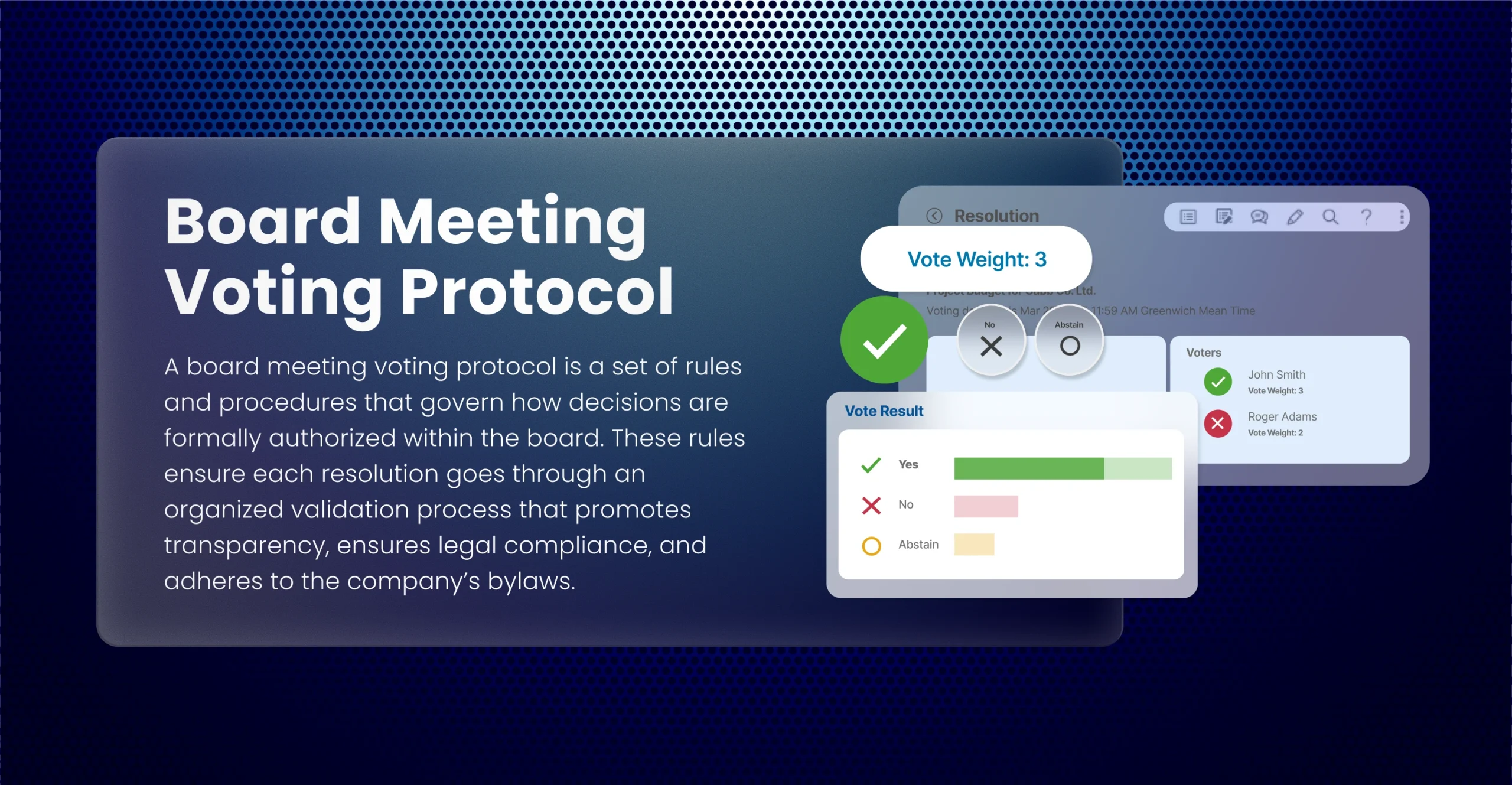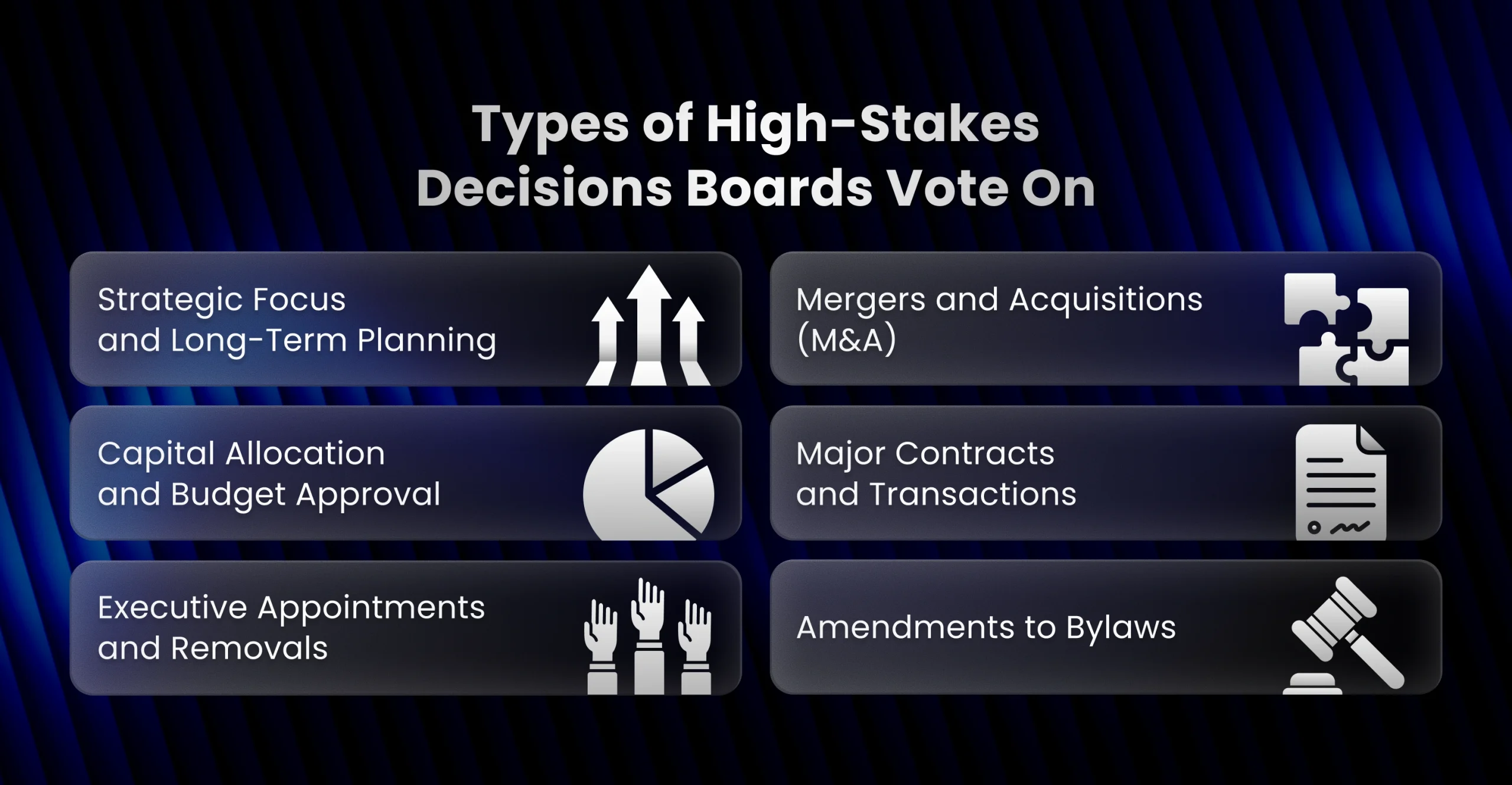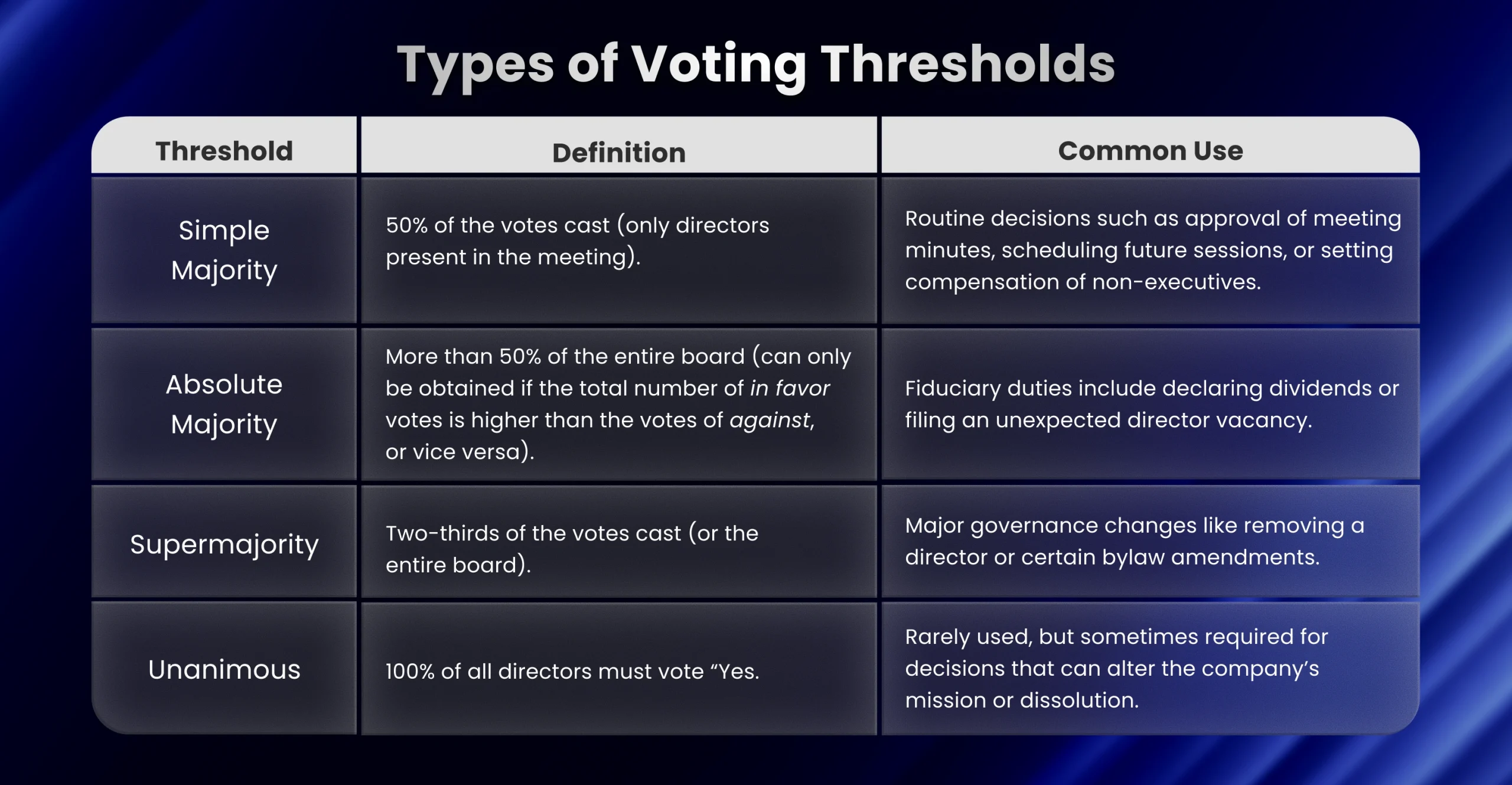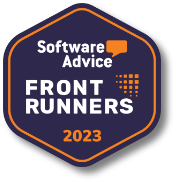Board meetings are not just confidential but also a tense discussion for strategy, accountability, and governance. The decisions made in that room, may it be authorizing a million-dollar acquisition or setting up the company’s vision for the future, do not become real simply because everyone’s willing to do it. Votes must be cast, counted, and properly recorded. In essence, a board’s vote moves the decisions into actionable, legally binding resolutions.
What is a board meeting voting protocol?

A board meeting voting protocol is a set of rules and procedures that govern how decisions are formally authorized within the board. Such protocols are legally binding and enforceable compared to casual decision-making. Some casual decision-making methods include voice votes or consensus seeking, which are non-binding and not legally enforceable.
These rules also ensure that each resolution, may it be approving audited financials or issuing shares, will go through an organized validation process that can withstand legal scrutiny. A board meeting voting protocol typically specifies:
- who may vote (based on the scope of board of directors voting rights),
- how the quorum is calculated, and
- how votes must be counted.
Implementing proper voting protocols cannot only promote transparency in how board decisions are made but also ensure legal and regulatory compliance. In some cases, these board voting rules are created so that time-sensitive decisions pass by simple majority, while high-stakes resolutions require supermajorities. These rules are primarily established in adherence to the company’s bylaws and parliamentary procedures such as the Robert’s Rules of Order.
Why is board voting important?
Board voting is imperative as it is the process that establishes board discussion as a legally binding corporate act that meets the fiduciary duty of care and duty of loyalty. Under most corporate governance systems (e.g., Delaware General Corporation Law in the U.S.), actions like approving a budget, hiring talent, or approving a merger are only effective after having been approved by a simple majority or supermajority of the board and recorded in the minutes.
In practice, the board of directors voting procedures can also act as risk controls. For example, requiring a supermajority vote to amend bylaws or approve a merger prevents an abrupt change to the organizational structure.
Types of High-Stakes Decisions Boards Vote On

It’s safe to say that voting is one of the board’s most critical responsibilities. Below are the most common high-stakes decisions that boards vote on, and why these types of votes are vital.
1. Strategic Focus and Long-Term Planning
Votes on strategic focus are primarily not just about endorsement of a single project, but more about formalizing priorities that will guide the organization for years. Boards vote on strategic resolutions directing long-term focus of the organization (e.g., entering new markets or divesting, ESG focus areas). Votes can be a simple majority or a supermajority if an important decision is being made. The passing of a resolution is what allows management to take action or implement a strategy with defined parameters established by the board.
2. Capital Allocation and Budget Approval
The board must approve the annual budget and capital deployment plan, typically by majority vote with oversight of the finance committee. Votes are required to determine how funds will be allocated between dividends, debt service, operating expenditures, and long-term investments. An approval establishes binding spending authority for management.
3. Executive Appointments and Removals
Boards are responsible for the appointment, evaluation, and removal of senior executives, particularly the Chief Executive Officer. These decisions should occur on a formal vote of the board, typically requiring a simple majority. However, bylaws may stipulate a supermajority vote for hiring or firing a CEO or Chair.
For instance, in December 2024, the Chicago Board of Education unanimously voted to fire Pedro Martinez as the CEO of Chicago Public Schools, following negligence in addressing inequities in schools. This clearly shows how a board vote reflects accountability to stakeholders, may it be the company shareholders, employees, or the public.
4. Mergers and Acquisitions (M&A)
Another critical issue that boards typically vote on is mergers and acquisitions. M&A votes are usually highly scrutinized as they can reform ownership or even competitive positioning of a company. In some cases, such votes are also subjected to a web of regulatory and political interests.
In a 2-1 vote, the Federal Communications Commission approved the $8 billion Paramount-Skydance merger following a 250-day review process. However, such divided outcome was marked by accusations of political pressure.
5. Major Contracts and Transactions
If a contract or transaction would exceed an established authority level, it would need board approval. Votes will formalize the authorization of contracts or transactions representing significant expenditure on key supplier contracts, financing, and partnership structures or restructuring. They also serve a requirement for directors to be aware of financial risk, counterparty risk, and governance compliance.
6. Amendments to Bylaws
Modifying bylaws, charters, or governance documents typically necessitates a “supermajority” of board approval. This sometimes even requires shareholder ratification. These votes may also change the board’s internal voting threshold, its duties, and the allocation of oversight authority. Since such votes can alter the board’s operating authority, formal documentation or record is necessary to ensure enforceability under corporate law.
How Board Meeting Voting Procedures Work: Step-by-Step
It’s a must to understand that for-profit and nonprofit board voting procedures are governed by corporate bylaws and state law. The board meeting voting protocol proceed as follows:
1. Meet the quorum
Prior to voting, a quorum must first be achieved. A quorum means the number of directors that need to be present at a meeting in order to conduct business. The bylaws typically define this number and are, in most cases, a simple majority (e.g., greater than 50%) of the number of present directors. In the absence of a quorum, there cannot be a voting process, nor legal actions taken.
2. Make a motion
A director suggests a specific course of action, clearly stating, “I move that…” as specified in the Robert’s Rules of Order. The motion needs to be concisely and clearly written so that the directors understand what they are voting on.
3. Second the motion
Another director must “second” the motion, in other words, they believe it is worthy of a discussion (not necessarily an agreement). If there is no second, the motion “dies” and there will be no further discussion.
4. Enter into a discussion or debate
Once a motion is seconded, the chair opens the floor to discussion. Directors may ask questions, propose amendments, offer their concerns, and argue for or against the motion. The chair will moderate the discussion to ensure fairness and order, and that all voices will be heard.
5. Call the question
After sufficient discussion, the chair (or a director) will “call the question” to put an end to discussion and move to vote. At this point, the motion may be amended or withdrawn if allowed.
6. Cast the vote
Votes are conducted in whichever format is allowed in the bylaws or rules (i.e., show of hands, roll call, secret ballot, electronic vote, etc.). Directors will vote in the manner permitted in the rules, as “Yes,” “No,” or “Abstain.” Quorum must be met before the voting proceeds. At the same time, if a motion meets the specified threshold in law or bylaw, it passes.

7. Announce and Record the Result
The chair announces the result of the vote counting, those in favor and against, and if there were any abstentions. The official minutes and board resolutions must include the final text of the motion, the number of votes in favor, the number of votes against, and the number of votes abstaining.
Best Practices for Board Meeting Voting Protocol
Effective voting protocols allow boards to move past compliance toward equitable, transparent, and defensible decision-making. Learn about the best practices you should integrate into board meeting voting procedures.
- Have clear voting procedures in the bylaws: Defining quorum, thresholds, and voting mechanisms in governing documents can preempt disputes and inform directors of the voting mechanisms before casting a vote.
- Choose the suitable voting methods: Voting mechanism—be it a roll call vote, show of hands, secret ballot, or secure digital voting—needs to match the degree of sensitivity of the issue. Sensitive matters may require anonymous voting or integrate audits in order to maintain integrity of process. For instance, the board will use a show of hands to approve their quarterly budget report, then switch to a secret digital ballot for highly confidential annual peer reviews.
- Distribute pre-meeting materials: Distributing resolutions, financial data, or supporting documents ahead of the meeting allows directors to comply with their duty of care and ensure informed voting, instead of hapless or hurried conversation.
- Ensure accurate documentation: The official minutes must contain the recorded motions, vote counts, absentions, and dissent. Proper documentation may serve as legal proof of board action and protection against contest in the future.
- Enforce “cooling-off” periods: When a decision is substantial or controversial, it is recommended to implement a “cooling-off” period prior to final voting. Delaying final voting can provide time for additional due diligence and independent evaluation of the board, and even reduce impulsive decision-making.
- Encourage post-vote justification: To fulfill their fiduciary responsibilities after a significant vote, directors must provide short rationale on their vote, either commence or at the next meeting directly following the vote. Documentation can help affirm that fiduciary duty has been met and gives the board additional protection against possible challenges from shareholders or legislature.
- Automate vote documentation: Leveraging tools like board portals allows for secure electronic voting, timestamped audit trails, and accurate meeting minutes, without the facilitator having to record the votes. The automation ensures integrity by eliminating clerical errors and provides security of voting, and safeguards the organization.
Board Meeting Voting Terminology
- Vote: A formal expression of a director’s choice or opinion (yes, no, abstain), leading to a collective decision-making.
- Motion: A proposal made by a director to facilitate board deliberation and debate.
- Second: A formal acknowledgement by another director that a motion deserves consideration; motions generally “die” without a second.
- Resolution: A formal, written decision that has been made following a passed vote.
- Amendment: A modification (deleting, adding, or replacing language) that attempts to modify a motion in advance of a vote on it.
- Quorum: The minimum number (or percentage) of directors required to be present in order for the board to conduct legitimate transactions.
- Majority Vote: A vote on a motion that must be affirmative by more than half of the votes cast to pass.
- Supermajority Vote: A higher threshold necessary for larger actions, such as bylaws and mergers.
- Unanimous Consent: When all directors agree to a motion without a formal vote.
- Abstention: The decision not to vote on a motion. The abstaining director is noted in the minutes, but does not count towards either side.
- Proxy Voting: This involves authorizing another individual (proxy) to make a director’s vote on his or her behalf.
- Tie Vote: When an equal number of votes has been cast for two outcomes.
- Roll Call Vote: A voting methodology where each director’s vote is called for and recorded, one by one.
- Secret Ballot: A confidential voting method utilized for controversial or sensitive matters, protecting anonymity.
- Point of Order: A procedural objection made by a director that challenges whether or not the board voting rules are being violated. The chair then makes a ruling on the point of order objection.
- Viva Voce: Voting by voice rather than by ballot or roll call.
- Adjournment: The formal closure of the board meeting, ending the session.
- Executive Session: A closed forum in a board meeting where confidential topics are discussed, without the presence of other staff.
Frequently Asked Questions About Board Meeting Voting Protocol
Can board members vote by proxy or remotely?
In general, directors cannot vote by proxy because the duty of care requires them to review the situation personally and deliberate on the merits. Nevertheless, some jurisdictions permit remote participation, which can be through video, phone, or other technology. Directors can also vote if it is authorized in the bylaws, and quorum requirements would be satisfied through remote participation.
What happens if quorum is not met?
Without a quorum, the board can discuss but cannot make decisions. The chair may adjourn the meeting or reassemble once quorum is achieved. Some bylaws also allow for a lower quorum for subsequent meetings.
How are tie votes resolved?
In tie votes, there is usually no majority, and the motion fails. Some boards permit the chair to have a casting vote, but should be authorized in the bylaws.
How are abstentions treated in board votes?
Abstentions are recorded in the minutes but are generally not included in the number of votes cast. However, they can indirectly influence outcomes, as long as the threshold is based on the number of directors present or voting.
Ensure Secure, Compliant Board Meeting Voting with Convene

Board voting is not just about decision-making, but also ensuring the process is secure and compliant with governance standards. This is why investing in a trust board portal is crucial to help maintain transparency and protect confidential data.
Convene Board Portal, a leading governance and meeting platform, is designed to help boards conduct a secure and seamless voting process. Whether directors gather in person or participate remotely, the platform can help you cast votes confidently while preserving compliance. Among Convene’s features are:
- Voting and Approval Workflow: Manage your board proposals, approvals, and outcomes in one digital flow. Convene AI, a new feature, also offers support for complex weighted voting and even automated meetings and AI-generated summaries of meeting files.
- Flexible Resolutions: Whether it’s a show of hands, a secret ballot, or in-meeting voting, Convene offers options for resolutions.
- Sign to Vote: Lock in every resolution with Convene’s integrated digital e-signature solutions, including Adobe Sign, DocuSign, POS DigiCert, Sayen, eSignaBox, and WeeTrust.
- Document Library: Securely access confidential board materials, from motion to resolution, with Convene’s document management function powered by multi-level permissions and encryption.
With Convene Board Portal, directors move from debate to decision in a smarter and faster way. Request a product demo of Convene now to learn more about its suite of features!
Jielynne is a Content Marketing Writer at Convene. With over six years of professional writing experience, she has worked with several SEO and digital marketing agencies, both local and international. She strives in crafting clear marketing copies and creative content for various platforms of Convene, such as the website and social media. Jielynne displays a decided lack of knowledge about football and calculus, but proudly aces in literary arts and corporate governance.











